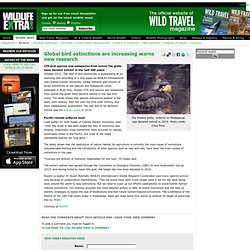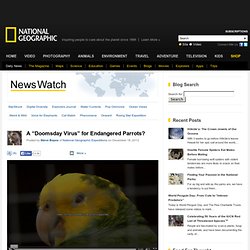

Oiseaux en difficultés. Global bird extinctions are increasing warns new research. The Alaotra grebe, endemic to Madagascar, was declared extinct in 2010.

Photo credit Chris Rose. 279 bird species and subspecies from across the globe have become extinct in the last 500 yearsOctober 2012. The rate of bird extinctions is accelerating at an alarming rate according to a new paper by BirdLife International and Charles Darwin University. Condors threatened by 'epidemic' lead poisoning from hunters' bullets (+video) California condors, one of the world’s most endangered species, are poisoned by lead from hunters’ bullets “at epidemic levels,” and will not recover unless more is done to prevent it, a study released Monday concluded.

Skip to next paragraph Subscribe Today to the Monitor Click Here for your FREE 30 DAYS ofThe Christian Science MonitorWeekly Digital Edition. Common birds are declining in North America. In 2007, the National Audubon Society (BirdLife in the US) published the results of the first-ever analysis of combined annual sighting data from the two major censuses of bird populations in North America—the Christmas Bird Count (CBC) and the Breeding Bird Survey (BBS) (Butcher and Niven 2007, Butcher 2007). Birds Going Extinct Faster Due To Human Activities. Human activities have caused some 500 bird species worldwide to go extinct over the past five millennia, and 21st-century extinction rates likely will accelerate to approximately 10 additional species per year unless societies take action to reverse the trend, according to a new report.
Without the influence of humans, the expected extinction rate for birds would be roughly one species per century, according to Stuart Pimm, professor of conservation ecology at Duke University's Nicholas School of the Environment and Earth Sciences, who is one of the report's principal authors. "What our study does, for the first time, is provide a well-justified and careful estimate of how much faster bird species are going extinct now than they did before humans began altering their environments," said Pimm, whose research group pioneered the approach of estimating extinction rates on a per-year basis.
Humans Are Driving Birds to Extinction, Group Warns. James Owen in Englandfor National Geographic News May 16, 2003 Conservationists warn that many birds face the same fate as their prehistoric ancestors, the dinosaurs. But it isn't an asteroid or volcanic eruption that's threatening to finish them off. The culprit, they say, stares at us from the bathroom mirror every day. Humans are singled out in a recent report as the cause of what many scientists believe is the biggest mass extinction of animals in 65 million years. A “Doomsday Virus” for Endangered Parrots? Every time we test blood from new endangered parrot species with small, isolated wild populations, we find Psittacine Beak and Feather Disease (PBFD) virus, a particularly nasty airborne circovirus that destroys the skin and feathers while opening large, painful fissures in the beak that eventually breaks it apart.

Cape parrots, black-cheeked lovebirds, Carnaby’s cockatoos, New Caledonian parakeets, Norfolk Island Green Parrot, red-fronted parakeets, swift parrot, orange-bellied parrot, and Echo parakeets are all endangered by catastrophic deforestation and/or widespread capture for the wild-caught bird trade, and ALL have high levels of PBFD virus in the wild population. Is this the “Doomsday Virus” for Endangered parrots? Five Bird Species Your Grandchildren May Never See, But Wish They Could. Palearctic-African migratory birds have suffered substantial declines. The number of montane endemic birds that go extinct in Australia depends on the degree of warming. Relationship between temperature, remaining range and predicted extinctions for 13 endemic forest birds in Australia The montane tropical rainforests of north-eastern Australia support 13 endemic bird species. Under global climate change, these forests are expected to shrink considerably. An increase of just 1°C (considered inevitable within the next few decades) will reduce the mean range of endemic birds by over 30%, as suitable climate space retreats to higher altitudes up mountain sides.
The reduction may be as much as 96% if temperatures rise 3.5°C. Get the Lead Out of Ammunition to Protect Wildlife and Human Health. California condor, © Christian Mehlführer Kim Delfino, California Program Director Bald eagle, ©Wes Gibson Who do you think we should be listening when it comes to wildlife policy?

Scientists or lead ammo lobbyists? That’s the key question confronting the California state legislature as it considers a bill requiring the use of non-lead ammunition for hunting. In Images: 100 Most Threatened Species. Le milan royal, espèce vulnérable, victime d'empoisonnement. Réchauffement climatique et répartition des oiseaux : les cas des îles Canaries et du Texas. 600 vultures killed by elephant poachers in Namibia. As the illegal poaching of African elephants and rhinos reaches epidemic levels, other species are also suffering catastrophic losses as a direct result of poachers' behavior.

A recent incident in July, where a poisoned elephant carcass led to the death of 600 vultures near Namibia's Bwabwata National Park, has highlighted how poachers' use of poison is now one of the primary threats to vulture populations. Poachers poison carcasses to kill vultures, since large flocks may give away the location of poaching activity, attracting the attention of law enforcement officials. "By poisoning carcasses, poachers hope to eradicate vultures from an area where they operate and thereby escape detection," explains Leo Niskanen, Technical Coordinator, IUCN Conservation Areas and Species Diversity Programme. "The fact that incidents such as these can be linked to the rampant poaching of elephants in Africa is a serious concern.
Cape vulture (Gyps coprotheres). White-backed vulture (Gyps africanus). Lead Ammo Poisons Condors in Grand Canyon.